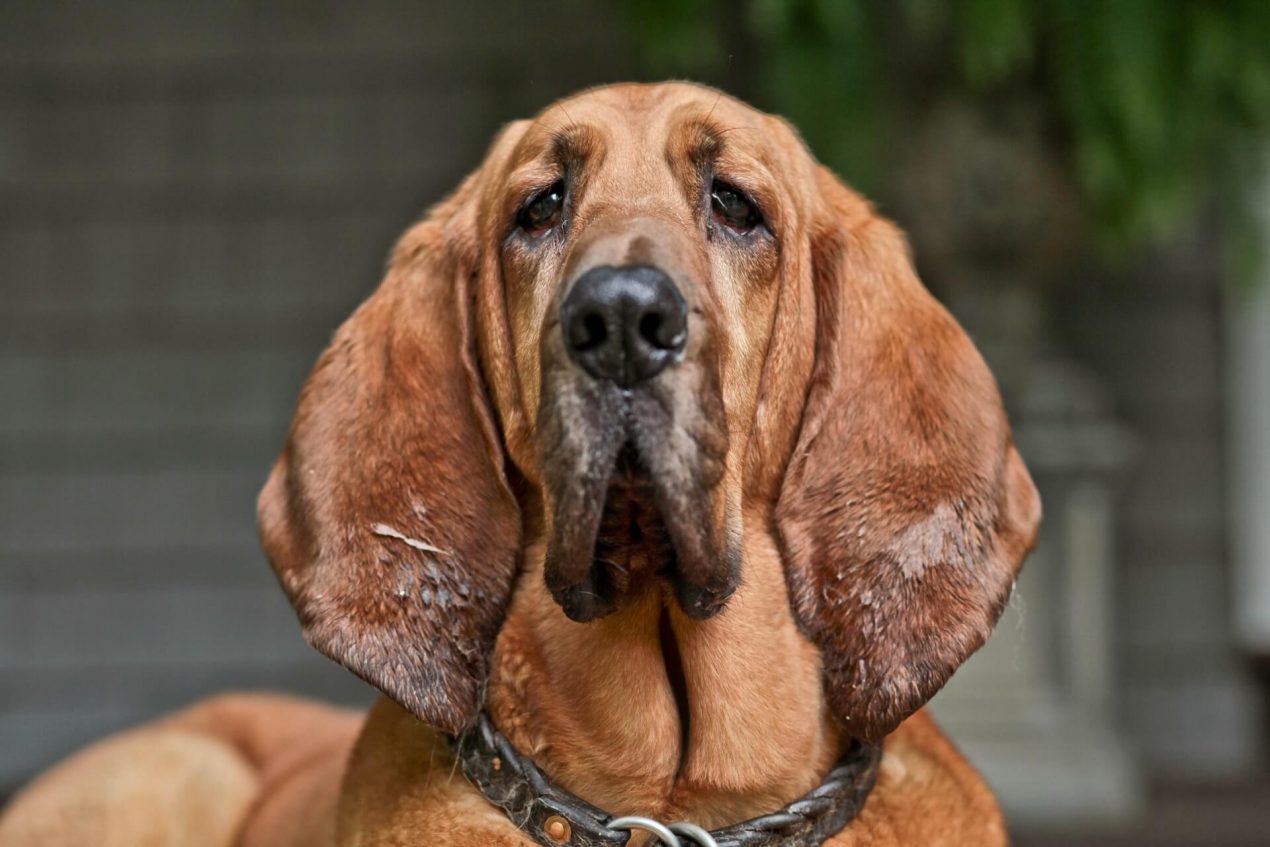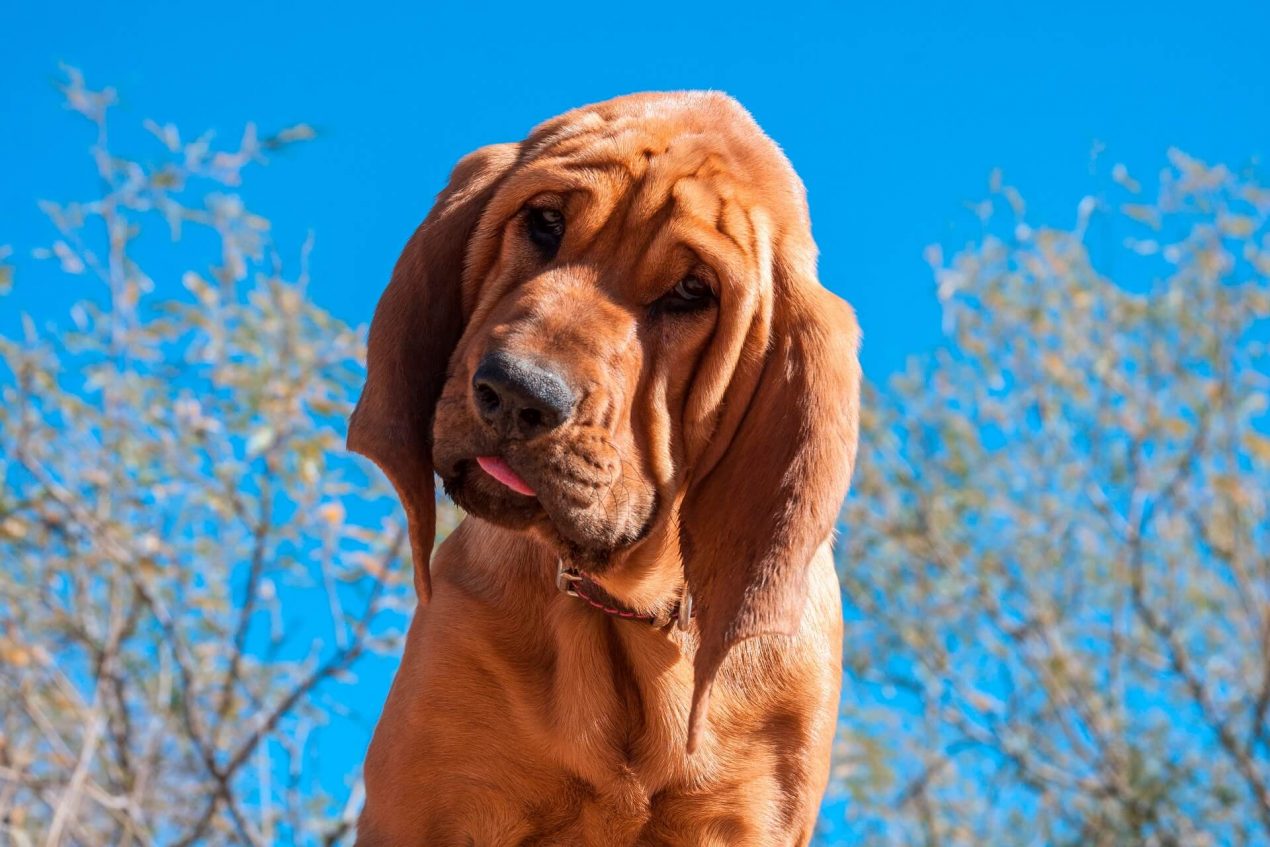A great scent nose and a striking appearance – the Bloodhound, also known as the St. Hubert Hound, is a very special dog, appreciated for both its keen sense of smell and its stubbornness. Those who choose this gentle breed from Belgium have an extremely dignified companion by their side, who follows its owner decisively. Due to its strong character, good training is essential for the dog and its owner to become a truly solid team. You can learn more about what makes a Bloodhound in this article.
History of the Bloodhound
The Bloodhound, also known as the “Hubertus Hound,” originally comes from Belgium. The first breeders named the Bloodhound “Chien de St. Hubert.” For many years, breeding focused on developing a good sense of smell. Additionally, breeding pairs were selected for their tireless obedience and gentle, friendly nature. The ancestors of today’s Bloodhounds are said to have faithfully aided humans in hunting as early as the 2nd century.
Belgian monks bred these hunting dogs with their characteristic appearance at the Saint-Hubert Monastery in the Ardennes for the nobility, who used these strong-willed dogs for hunting. Later, the Bloodhound was employed by the police for its excellent sense of smell – it is said to be able to track a criminal’s trail even after days.
Breed Overview
GROUP: Hound
HEIGHT: 25 to 27 inches (males); 23 to 25 inches (females)
WEIGHT: 90 to 110 pounds (males); 80 to 100 pounds (females)
COAT: Short, dense, and loose fur with many folds around the face, neck, and ears
COAT COLOR: Black and tan, liver and tan, or red
LIFE SPAN: 10 to 12 years
TEMPERAMENT: Active, loving, even-tempered, stubborn, gentle
HYPOALLERGENIC: No
ORIGIN: Belgium
Nature and Character
The Bloodhound exudes incredible calmness. It is gentle and always friendly. With the right training, it makes a perfect family dog. It plays tirelessly and behaves extremely sociably. Once it picks up a trail, its determined nature becomes apparent. It does not have a pronounced barking behavior but remains relaxed in every situation. To some, the Bloodhound may seem quite headstrong, but with proper guidance, this makes it a particularly charming dog. If you adopt a Bloodhound puppy, you should start training it immediately. Bloodhound puppies are extremely intelligent and learn very quickly.
Incorrect or insufficient training or socialization can have disastrous consequences. Therefore, you should teach a young Bloodhound early on where the boundaries are. This is usually not too difficult, as this very old breed of dog likes to follow and wants to be part of the pack. Never punish a Bloodhound without reason, as these large dogs are very sensitive.
| Affection Level | High |
| Friendliness | High |
| Kid-Friendly | High |
| Pet-Friendly | High |
| Exercise Needs | High |
| Playfulness | Medium |
| Energy Level | High |
| Trainability | Medium |
| Intelligence | High |
| Tendency to Bark | High |
| Amount of Shedding | High |
Acquisition of a Bloodhound
Unfortunately, Bloodhounds have fallen out of fashion, and there are only a few Bloodhound breeders left in the United States. If you have decided to adopt a dog of this breed, you should contact Bloodhound breeders early enough and be prepared for a somewhat longer waiting period if necessary. If you cannot find a suitable breeder on your own, you can inquire with the official national Bloodhound clubs. These exist in the United States as well as in France, England, the Netherlands, Belgium, and Germany .

What to Consider When Buying a Bloodhound?
Take a good look at the breeder and their Bloodhounds. A reputable breeder will not only show you the pedigree but also introduce you to the parent animals. Some may even facilitate contact with adult dogs from their breeding. While not essential for recognizing a good Bloodhound dealer, this can assist you in your decision-making process. Additionally, you should find the breeder likable and responsive to all your questions in a friendly manner. It’s also important that the breeder treats their Bloodhounds as family members. This ensures that your Bloodhound puppy already has a minimum level of socialization.
Also, pay attention to the completeness of the official papers, which should include the following:
- U.S./EU papers
- Pedigree
- Vaccination record with proof of existing microchips
- Breeding book
Development and Training of the Puppy
As mentioned earlier, a Bloodhound is both gentle and calm as well as strong-willed and independent. Seek support from a reputable dog training school for their education. Here, the Bloodhound learns not only the basic commands but also interacts with dogs of different breeds. A Bloodhound requires loving but consistent training. It can sometimes react very sensitively and should always understand why you are praising or admonishing it. Since it was bred for hunting, it is advisable to take advantage of this and teach your Bloodhound to track. You can incorporate this into regular play/training sessions.
How to Care for a Bloodhound?
Do you have a house with a garden? Wonderful, as this is where a Bloodhound feels most comfortable. This large breed loves being outdoors and sniffing out new scents. If you live in a city apartment and want to keep a Bloodhound, make sure he gets plenty of exercise every day. If you have to work a lot, a suitable dog sitter can take over. A Bloodhound should be physically and mentally stimulated every day. So, vary your walks and regularly explore new parks and forests with your dog.
Activities with the Bloodhound:
As you’ve already learned, the Bloodhound was bred for hunting. This breed of dog, therefore, needs plenty of exercise and mental stimulation. Thanks to its good nose, it is often used as a police dog or search and rescue dog. If kept as a family pet, activities such as tracking and mantrailing with the Bloodhound are highly recommended.

Health and Grooming
Bloodhounds are considered extremely robust and capable dogs, rarely falling ill. However, Bloodhounds also have some breed-specific diseases.
These include:
- Eye problems such as acute or chronic conjunctivitis caused by the loose and hairy eyelids
- Ear problems such as ear mites caused by the long and droopy ears
- Hip and elbow dysplasia
- Skin inflammation in highly wrinkled areas such as the head and neck
Apart from these potential illnesses, which the dog should be regularly examined for, a Bloodhound is considered extremely resistant to disease. Additionally, grooming a Bloodhound’s coat is extremely simple. It is sufficient to brush the short fur from time to time. A good time for this is during shedding.
Interesting Facts About the Bloodhound
Even the ancient Germans appreciated this breed of dog more than a thousand years ago. Old books show that a Bloodhound, or “Schweißhund” as it was often called in the past, was worth more than a horse.
Do you own a Bloodhound or plan to get one? Share with us in the comments what makes them special in your opinion!


